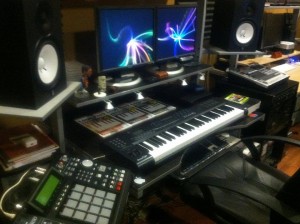
My Lab
Just yesterday I was having a chat with another musician/producer over Gmail. We were talking about related topics regarding music production. Part of the discussion was about his loose timing of the hi-hat in hip hop to give that “bounce”, another was about using Battery 3 vs Battery 4 as a drum plugin in your DAW of choice, we switched to using Reason 7 vs Live 9 for production, yet another topic was about knowing when not to succumb to gear lust (he has a modular synth being delivered next week) and to make music with the tools (gear) you have. Yet another topic was the bass guitar track I recorded on a recent song and his enjoyment of how it sounded in the mix. The gist of all those topics made me think of a related blogpost I wrote about a year and a half ago on the subject of music composition today.
Ironically, this evening, I visited the blog of David Frank, of The System. He and Mic just released “System Overload”, all brand new tracks and a new edit of their hit “Don’t Disturb This Groove”. I, like many die hard fans of The System, was excited to see and hear them come back together to record brand new music, music which was defintely worth the wait.
Back to David’s blog. He posted (yet another) very interesting article that shares his insight on how some of the ways he composes music for The System. David is classically trained, as well as technically sharp in electronic music composition/production. If you’ve ever (especially) heard live interviews, with David, he continually talks about how his musical training and use of gear, over the years, play their distinct roles in his composition. It’s insight like this that I don’t ever recall seeing in any other similar interviews I’ve read.
I’ve had many discussions with artists/songwriters/musicians who use digital audio workstations and sample libraries to compose their music, with regards to how urban contemporary and pop music is often arranged and composed today.
This can be debated, most certainly. The use of DAWs today, undoubtedly, make popular music composition easier (for lack of a better phrase) because of the features built in. I personally find David’s approach not just insightful, but very interesting (but of course this is due to my own journey and level of musical training as a musician). What say you?
::: oceans of rhythm :::
Fresh.

Wow….great blog post! I think the answer to most of the questions you ask at the end of your post are a resounding YES! I know with Hip Hop music there aren’t many artists doing much in the way of melodic expression or lead soloing. At the same time the lack of these elements in Hip Hop is what makes a “Hip Hop” beat what it is to a certain degree. It would seem that if the boundaries of melody in a Hip Hop track are pushed too far the track transform to another genre. I’m a self taught musician and I make Hip Hop beats…I personally would love to see more melodic expression in Hip Hop production…and this as a listening experience (without an emcee) is very enjoyable akin to Jazz (thought that comparison my be a stretch for some). Some of the artist that are pushing this envelope when it comes to melodic expression in beat based Hip Hop are Flying Lotus, MNDSGN and Herrmutt Lobby. 🙂
I haven’t searched to see if he has a blog or website, but some cat named Andrae Young is really old-school in his approach to music production (analog mixers, reel-to-reel, ect). He’s trying to grab some of the old stuff and “push-it-forward”.
Though I think music has progressed naturally, and nothing has really been “left behind”; songs/styles get recycled all the time.
Anyway, I heard him interview on NPR a few months ago. It was an interesting listen.
B,
Excellent reply, bro. I’ve heard of Flying Lotus, I like his stuff, but I definitely need to checkout MNDSGN and Herrmutt Lobby. Google here I come!
I definitely have to search NPR for this cat Andrae Young. Thanks for the tip, Rezzy!